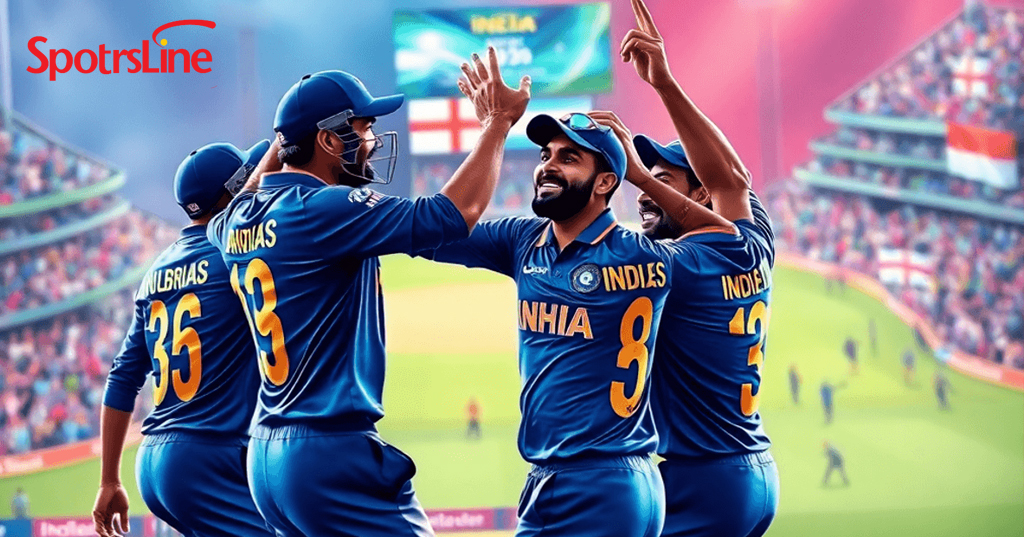
Ind vs Eng Cricket Update: Key Highlights from the Latest Match
India’s dominant victory over England in the ICC Cricket World Cup 2023 has sent shockwaves through the cricketing world. The match showcased India’s rising strength as title contenders while highlighting England’s struggles in the tournament. Let’s know more about ind vs eng.
This high-stakes encounter at the Ekana Cricket Stadium saw India crush England by 100 runs. The defending champions faced a brutal reality check as India extended their unbeaten streak in the World Cup.
In this match analysis, you’ll discover:
- A detailed breakdown of India’s batting masterclass led by Rohit Sharma
- Key insights into England’s bowling strategy and execution
- Critical moments that shifted the game’s momentum
- Match-winning performances from Mohammed Shami and Jasprit Bumrah
- Tournament implications for both teams
- Post-match reactions from players and team management
The clash between these cricket powerhouses lived up to its billing as a crucial World Cup fixture. India’s clinical performance reinforced their status as tournament favorites, while England’s campaign faces serious challenges ahead.
Match Overview
The cricket showdown between India and England unfolded at the Bharat Ratna Shri Atal Bihari Vajpayee Ekana Stadium in Lucknow on October 29, 2023.
This match marked a crucial point in the tournament, with India riding high on a perfect winning streak. The defending champions England faced mounting pressure after three losses in their previous four games.
The historical rivalry between these cricket powerhouses adds an extra layer of intensity to their encounters. Their last World Cup face-off saw England emerge victorious in the 2019 group stage match at Edgbaston.

Key match conditions:
- Pitch: Slow-paced track with variable bounce
- Weather: Clear skies, temperature around 28°C
- Toss: England won and chose to bowl first
- Crowd: Near-capacity attendance of 50,000 fans
The Ekana Stadium, known for its spin-friendly conditions, set the stage for this high-stakes battle. England’s decision to bowl first aligned with the venue’s history – teams batting second had won 60% of day-night matches here.
This encounter carried extra significance as both teams needed a win for different reasons – India to cement their semifinal spot, England to keep their qualification hopes alive.
India’s Batting Performance
India’s batting display showcased a perfect blend of aggression and strategic play. The opening partnership between Rohit Sharma and Shubman Gill set an attacking tone from the first ball.
Rohit Sharma’s Masterclass
- Scored a brilliant 87 runs off 101 balls
- Hit 10 fours and 3 sixes
- Dominated England’s pace attack in the powerplay
- Played crucial shots through the cover region
The Indian captain’s innings proved vital in building a strong foundation. His partnership with Shubman Gill reached 45 runs before Gill departed for 16.
Suryakumar Yadav’s Impact
- Quick-fire 49 runs from 47 balls
- 4 boundaries and 2 sixes
- Innovative shots against spin bowlers
- Built a 73-run partnership with Rohit
Suryakumar’s aggressive batting style kept the scoreboard ticking. His ability to find gaps and play unconventional shots put pressure on England’s bowling lineup.
KL Rahul’s Steady Hand
- Scored 39 runs from 58 deliveries
- Maintained a strike rate of 67.24
- 3 well-timed boundaries
- Stabilized the middle order
The partnership between Rahul and Suryakumar proved crucial during the middle overs. Their running between wickets created constant pressure on England’s fielders.
Key Batting Highlights
- Total team score: 229/9 in 50 overs
- Run rate maintained at 4.58 per over
- 24 boundaries hit during the innings
- 8 sixes scored by Indian batsmen
India’s batting strategy focused on building partnerships. The top order’s performance laid a strong platform, while the middle order maintained steady momentum through calculated risk-taking.
The team’s approach against England’s spinners showed clear planning. Batsmen used their feet effectively against Adil Rashid, preventing him from settling into a rhythm.
A mix of conventional and innovative shots kept England’s field placements under constant adjustment. The batting unit’s ability to rotate strike prevented pressure from building at any stage.

England’s Bowling Analysis
England’s bowling attack faced a tough challenge against India’s formidable batting lineup. Their strategy centered on mixing pace variations with strategic spin bowling to disrupt India’s rhythm.
Adil Rashid’s Standout Performance
- Precise line and length control
- 2 crucial wickets in middle overs
- Economy rate of 4.8 runs per over
- Strategic deployment against India’s top order
The English pacers struggled to make early breakthroughs. Mark Wood’s express pace touched 145 km/h but yielded 49 runs in 7 overs. Chris Woakes maintained pressure with tight lines, securing 1 wicket for 38 runs in his 8-over spell.
Bowling Statistics Breakdown:
- Adil Rashid: 10-0-48-2
- Mark Wood: 7-0-49-1
- Chris Woakes: 8-0-38-1
- Sam Curran: 6-0-47-0
- Moeen Ali: 9-0-45-1
Sam Curran’s left-arm variations proved costly against India’s right-handed batsmen. His six overs went for 47 runs without any wickets. Moeen Ali provided support with his off-spin, picking up one wicket while maintaining an economy of 5 runs per over.
Key Bowling Phases:
- Powerplay: 1-41 in first 10 overs
- Middle Overs: 3-89 between overs 11-30
- Death Overs: 1-72 in final 10 overs
England’s death bowling showed signs of weakness. Their pacers struggled to contain India’s aggressive batting in the final overs. The absence of variation in yorker execution allowed Indian batsmen to score freely.
The bowling unit’s field placements reflected their defensive mindset. Captain Jos Buttler’s decision to spread the field early reduced catching opportunities but failed to stem the flow of runs.
England’s Batting Struggles
England’s batting lineup crumbled under India’s relentless bowling attack. The defending champions managed a mere 129 runs, their second-lowest total in World Cup history.
Key Batting Collapses:
- Dawid Malan (16) fell early to Mohammed Shami’s precise yorker
- Ben Stokes departed for a duck, caught behind off Bumrah
- Joe Root struggled to read the swing, scoring just 11 runs
Liam Livingstone’s brief resistance (27 runs off 46 balls) stood as the highest individual score. His cautious approach reflected England’s defensive mindset against India’s disciplined bowling.
Mohammed Shami emerged as the wrecker-in-chief with remarkable figures of 4/22. His spell included:
- Perfect seam position
- Strategic variations in pace
- Precise yorkers at death overs
The match turned decisively when Shami dismissed Jos Buttler (9) with a stunning inswinger. This wicket triggered a collapse, with England losing their last six wickets for just 39 runs.
Critical Game-Changing Moments:
- Buttler’s dismissal in the 16th over
- Moeen Ali’s run-out after a mix-up with Livingstone
- Chris Woakes’ golden duck to Kuldeep Yadav
England’s batting struggles exposed their vulnerability against quality pace bowling. Their technique against moving balls raised concerns, particularly their tendency to play away from the body.
The pressure mounted with each dot ball as India’s fielders maintained intensity. England’s run rate dropped below four per over, forcing batsmen to take risks against disciplined bowling.
Shami’s spell earned him career-best figures in World Cup cricket. His ability to extract movement off the surface proved too challenging for England’s middle order.
Player Performances and Match Statistics
Rohit Sharma’s masterclass earned him the Player of the Match award with his brilliant 87-run knock. His innings included:
- 11 boundaries
- 2 sixes
- Strike rate of 142.62
- Time at crease: 101 minutes
The Indian skipper’s aggressive batting style set the perfect platform for India’s commanding total of 229/9 in 50 overs.
Jasprit Bumrah’s exceptional bowling spell proved crucial for India’s victory. His figures stood at:
- 3 wickets for 32 runs
- Economy rate of 3.20
- 2 maiden overs
- 4 dot balls in the power play
The match statistics painted a clear picture of India’s dominance:
India’s Key Contributors:
- KL Rahul: 39 runs (43 balls)
- Suryakumar Yadav: 49 runs (47 balls)
- Ravindra Jadeja: 2 wickets, 27 runs
England’s Notable Performances:
- Ben Stokes: 38 runs (56 balls)
- Dawid Malan: 31 runs (42 balls)
- Adil Rashid: 2/35 in 10 overs
The final scorecard reflected India’s comprehensive win:
- India: 229/9 (50 overs)
- England: 129 all out (34.5 overs)
The match statistics highlighted India’s superior performance in all departments. The 100-run victory margin stands as their largest against England in World Cup history. India’s bowlers maintained an impressive economy rate of 3.70, while their batsmen struck at 137.82 throughout the innings.
Tournament Implications and Future Outlook
India’s dominant win against England has strengthened their position at the top of the ICC Cricket World Cup standings. With 14 points from 7 matches, India remains unbeaten in the tournament.
The victory has secured India’s spot in the semifinals with two group-stage matches still to play. Their remaining fixtures against South Africa and Netherlands now offer opportunities to:
- Fine-tune team combinations
- Rest key players
- Test bench strength
- Maintain winning momentum
England’s situation looks bleak after this defeat. The defending champions sit at the bottom of the points table with just 2 points from 7 matches. Their chances of reaching the semifinals are now mathematically impossible.
India’s bowling attack has emerged as the tournament’s most lethal unit. The combination of Bumrah, Shami, and Siraj poses a serious threat to any batting lineup in the knockout stages.
The team’s batting depth adds another layer of confidence. Rohit Sharma’s form at the top, supported by Virat Kohli’s consistency, makes India strong contenders for the trophy.
England must now focus on rebuilding their white-ball cricket strategy. Their remaining matches against Australia and Pakistan will be crucial for:
- Restoring team morale
- Testing new combinations
- Planning for future tournaments
- Salvaging pride in the competition
Reactions and Insights from Players and Captains Post-Match
England captain Jos Buttler expressed deep disappointment in the post-match press conference. “Our batting performance fell short of expectations. We needed to show more resilience.”
The England skipper praised Mohammed Shami’s bowling spell: “His line and length were exceptional. He made it tough for our batsmen to score.”
Key Player Comments:
- Ben Stokes acknowledged India’s superior performance: “They outplayed us in all departments. We must learn from this defeat.”
- Rohit Sharma shared his batting approach: “I focused on playing each ball on merit. The pitch offered good bounce.”
- Joe Root highlighted areas for improvement: “We need better partnerships. Our shot selection must improve.”
Despite the loss, England’s fielding coach highlighted some positives:
- Sharp catches by Ben Stokes and Jonny Bairstow
- Improved ground fielding compared to previous matches
- Strong bowling spells from Adil Rashid
“Our fielding standards remain high,” noted England’s fielding coach. “We saved crucial runs through excellent boundary work.”
The Indian dressing room celebrated their clinical victory. “This win boosts our confidence,” said coach Rahul Dravid. “The team executed our plans perfectly.”
FAQs (Frequently Asked Questions)
What was the date and venue of the India vs England match?
The match took place on October 29, 2023, at the Bharat Ratna Shri Atal Bihari Vajpayee Ekana Stadium.
Who were the standout performers for India in this match?
Rohit Sharma scored 87 runs, Suryakumar Yadav contributed 49 runs, and KL Rahul added 39 runs to India’s total.
How did England’s bowling perform in the match?
England’s bowling performance featured a strong showing from Adil Rashid, but overall they struggled against India’s batting lineup. Mohammed Shami’s exceptional bowling for India included taking 4 wickets for just 22 runs.
What were the critical moments that affected England’s batting?
England faced a significant batting collapse, with Liam Livingstone only managing to score 27 runs. Key wickets taken by Mohammed Shami shifted the momentum of the game in favor of India.
What are the implications of this match for the ICC Cricket World Cup standings?
This match had a considerable impact on group standings, particularly enhancing India’s journey towards securing a spot in the semifinals while affecting England’s position.
What were some reactions from players and captains after the match?
Jos Buttler expressed disappointment regarding England’s overall performance but noted positive takeaways from their fielding and bowling efforts.

